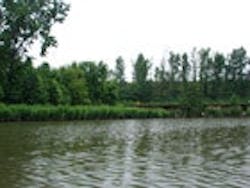Great Lakes Legacy Act Ottawa River Cleanup Begins
U.S. Environmental Protection Agency (EPA), the Ottawa River Group and the state of Ohio have begun dredging 240,000 cu yd of contaminated sediment from a 5.5-mile section of the Ottawa River in Toledo, Ohio. The first phase of the project--removing 10,000 cubic yards of sediment from Sibley Creek--was completed in April. The $49-million cost of the total project will be split between EPA, using Great Lakes Legacy Act funds, and the Ottawa River Group.
”Removing contaminated sediment from the river will ultimately benefit water quality in Maumee Bay and Lake Erie,” said EPA Great Lakes National Program Office Director Gary Gulezian. “We expect this eighth cleanup funded by the Great Lakes Legacy Act to be another successful project that will help improve the environment and the local economy.”
“Today we celebrate the start of dredging work that will create a rebirth of the Ottawa River,” said Chris Korleski, Ohio EPA director. “This project is a prime example of what the Great Lakes Legacy Act funds were intended to do. The federal, state and local partners have been given an opportunity to change the legacy of this river, and I look forward to the day that we can stand on the bank and admire a very different kind of river than the one we see today.”
“The Ottawa River Group is pleased to partner with U.S. EPA's Great Lakes National Program Office in an effort to cleanup historical contaminants from the Ottawa River and provide a revitalized Ottawa River system for residents of northwest Ohio,” said Bob Rule, project coordinator for the Ottawa River Group.
The goal of the project is to reduce impacts to human health and the environment from the Ottawa River. Sediment (mud) in the river is contaminated with a mixture of heavy metals, PCBs and polycyclic aromatic hydrocarbons called PAHs. The sediment contamination in the Ottawa River is a key contributor to the fish advisories currently in place and limit the amount of fish that can be safely eaten.
Dredging activities in the Ottawa River began May 1 and are expected to be complete by late 2010. The sediment will be removed using hydraulic cutterhead dredges--large suction systems that pull in the sediment and river water and pump them to the Hoffman Road Landfill where they are processed. The water is collected and treated to meet discharge standards before it is returned to the river.
About 7,000 cu yd of sediment with the highest concentrations of PCBs will be treated separately. Because of high PCB levels, this sediment will be sent to a specially permitted landfill in Michigan that is licensed to accept this type of waste.
EPA is providing $24.5 million for the project through the Great Lakes Legacy Act, a federal program targeted at cleaning up contaminated sediment in Great Lakes Areas of Concern. The Ottawa River Group will provide the remaining $24.5 million. The city is providing space in its municipal landfill as its cost share.
Source: U.S. EPA
